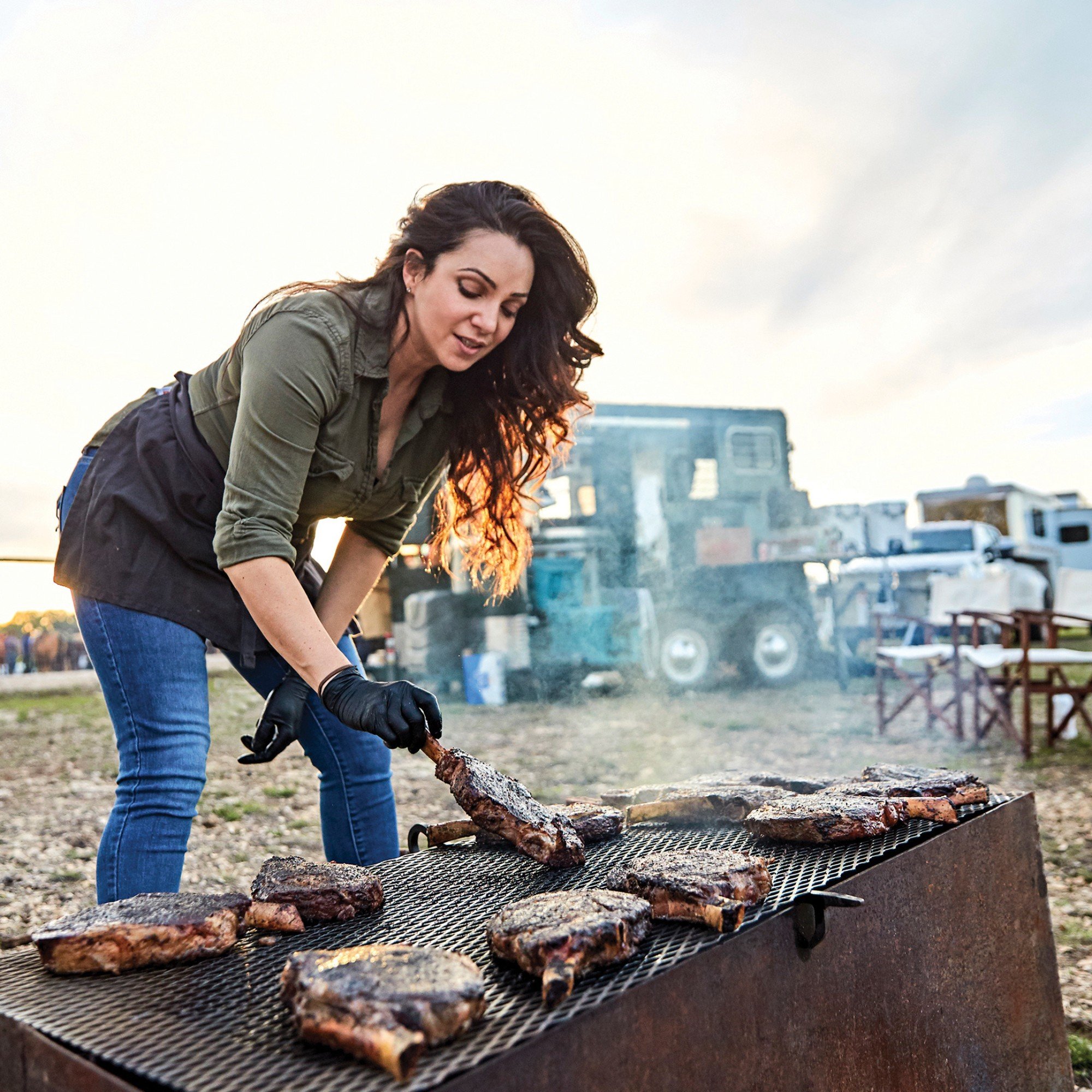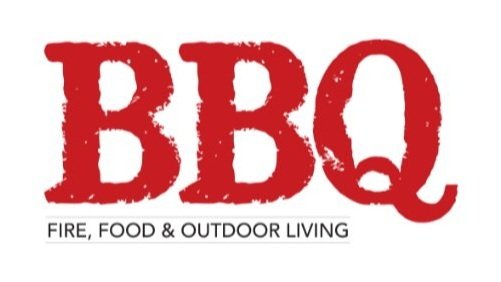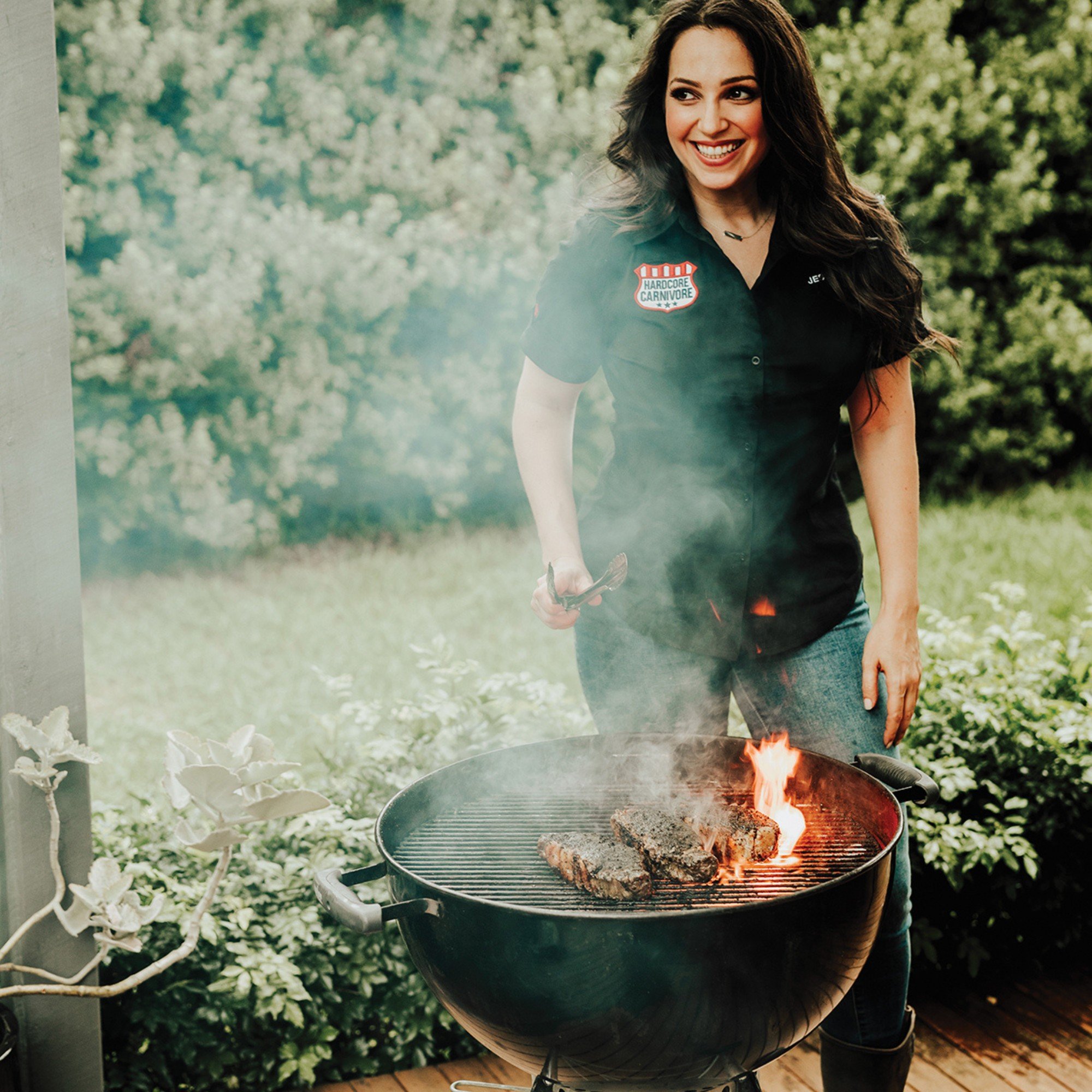
Hardcore
Carnivore
For Jess Pryles, meat is a science, a lifestyle and a living, as she explains to RUPERT BATES from her Texas home
You can take the Australian out of Australia and all that, but with vegemite an ingredient in one of many succulent recipes, Jess Pryles, now “Texan by choice”, doffs her cowboy hat to her Melbourne roots.
Pryles grew up in the Victorian capital’s South Yarra suburb. While Australians are
no strangers to barbecues and backyard grilling, it was a trip to Texas that transformed both Pryles’ palate and life.
“I’ve always loved to eat meat, even if in Australia it seemed it was only ever well done. But I was fascinated by the United States and Texas, with its history of barbecues, cowboys – the Lone Star State. And as a tourist you eat barbecue.”
The first bite of smoked beef ribs in a Texas BBQ joint was a seminal moment
for Pryles. “It was like nothing I had ever tasted before.” Head to her website, www.jesspryles.com, and you find a recipe for “a beef rib big enough to make a Flintstone jealous” – proof of her compelling voyage from novice to expert.
“Smoked BBQ beef ribs are a thing of beauty. A crust of impossibly dark bark, the vivid scarlet smoked ring and beefy strands of tender rib meat,” says Pryles.
From that first bite, the “naturally curious” Pryles wanted to learn more – much more. Back in Australia she looked to cook Texan BBQ. She’d question butchers about cuts and learn about the meat’s provenance and tendencies.
“It led me down a road of understanding beef breeds, the meat industry, slaughter ages, butchery styles and that the same name didn’t always mean the same product. I went in search of all the answers.”
Pryles enjoys sharing her education on her website, combining the knowledge and science accrued with a wealth of recipes. “My desire to demystify the process seems to resonate with people.”
She kept returning to the city of Austin in Texas, where she made great friends around the fire, loving the nightlife and lifestyle, hanging out with pit masters, before heading back to Australia as “a bit of a meat missionary” and co-founding the Australasian Barbecue Alliance, promoting low and slow in Australia and New Zealand.
She hesitates to criticise her homeland, but her Texan adventures only heightened the difference and Australia still seemed stuck with the simple, if endearing, ‘sausage sizzle’ outside the hardware store at weekends.
“Wheel out a flat-top grill, cremate a sausage, fry some onions and stick it between white bread with tomato sauce. The backyard BBQ in Australia was quite limited too.”
Back in Austin, there was more innovation and risk-taking, looking to develop signature recipes and construct new sauces and rubs to embellish the meat. Australia in turn has upped its home cooking game, fired by the popularity of TV kitchen shows, not to mention the multiculturalism of Australia bringing fresh influences and flavours, be they Greek, Asian or American.
Texas-style barbecue, wedded to its ranching heritage, is very beef heavy, says Pryles, with coarse seasoning and rustic in outlook with not a lot of sweet sauces. You tended, born of necessity and availability, to cook what you reared over the wood that you chopped, be it hog over hickory, beef over oak, or mesquite, depending which part of the state you were in.
“Now the real aficionados keep multiple different wood piles to cherry pick from, matching the wood flavour to whatever they are cooking.” Culinary state lines got blurred and a hybrid approach taken, such as combining the best Texan brisket with a whole hog from the Carolinas and burnt ends from Kansas City.
“Yes the various states are competitive and proud, but it is the people eating the BBQ who are the real winners,” says Pryles.
While local, sustainable produce is important, Pryles says it can be “over-romanticised” as there has to be a commercial viability too in where meat is sourced from, given the quantities and consistencies required.
“BBQ started as a way to reuse undesirable cuts, turning cheap meat into something edible.”
Pryles cites the example of Lance Kirkpatrick of Stiles Switch BBQ in Austin cooking ‘a small farm’ in vast steel fire pits – briskets, pork ribs, beef ribs, chicken and sausages. 160 cows a week is not uncommon for briskets alone at Stiles Switch. “All that meat has to come from somewhere.”
Pryles moved full-time to Austin five years ago and is married to a Texan.
She has built a substantial social media following, sharing recipes and advice, establishing herself as a leading BBQ authority.
Along came her own seasonings and rubs and the Hardcore Carnivore brand was established, including a cookbook. More merchandise has followed, including knives, T-shirts, butcher’s aprons and even a Beef Chief trucker cap. She has also designed a signature Jess Pryles offset smoker in conjunction with Houston-based Pitts & Spitts. But meat is at the heart of everything Pryles does, be it the science, the journey or the cooking.
“Fundamentally it is about what I like to eat and cook and sharing that with people.”
Her key BBQ tips are to buy the best meat you can afford because the quality will make a difference to the final cook and taste and that practice makes perfect. While online videos can provide guidance, don’t go too far down the YouTube hole, says Pryles.
“The best way to learn is trial and error. Meat is an organic product and no two briskets will reach the same temperature at the same time, or behave in the same way, with so many variables. Cook simply and get to understand your cooker and meat and then add more complicated components.”
“Live fire cooking is in just about every culture. There is so much more to explore and places for BBQ to grow.”
The Hardcore Carnivore’s appetite remains unsated and the barbecue community is all the richer for it. As for that staple of the Australian larder, vegemite, Pryles has a vegemite-glazed lamb rack recipe. ‘Australian by birth, Texan by choice’ indeed.








